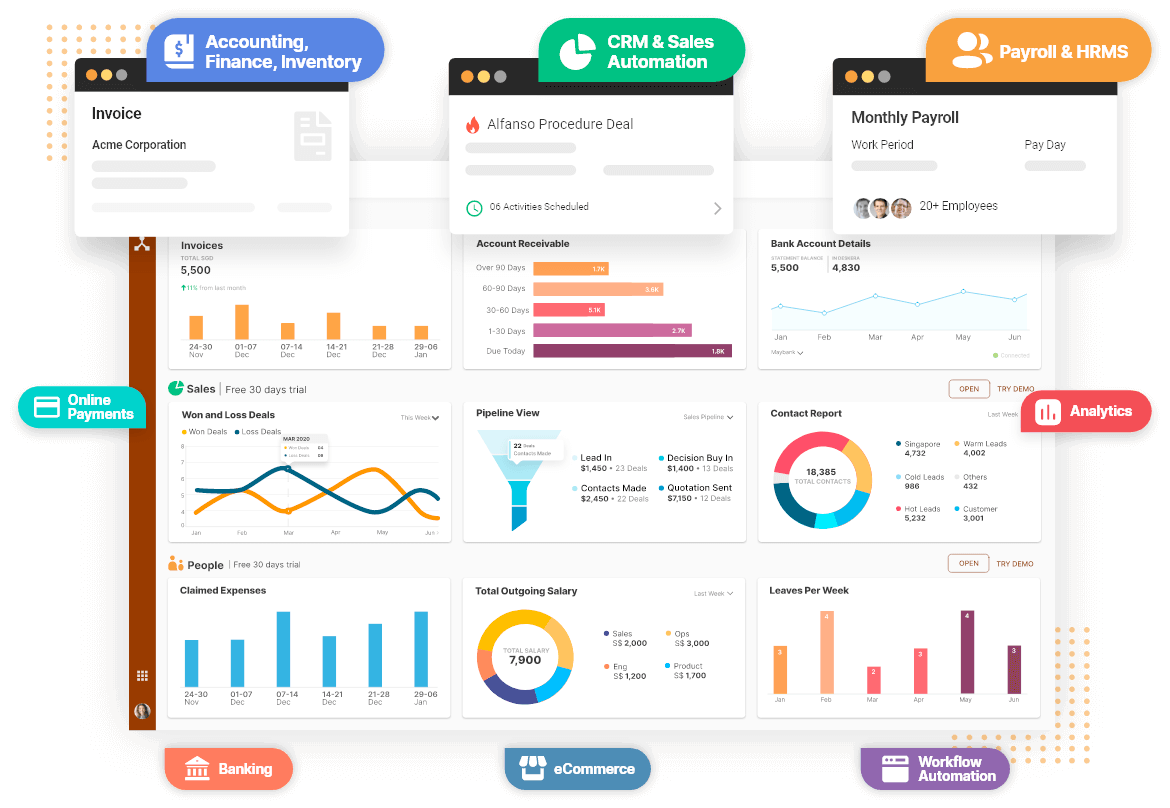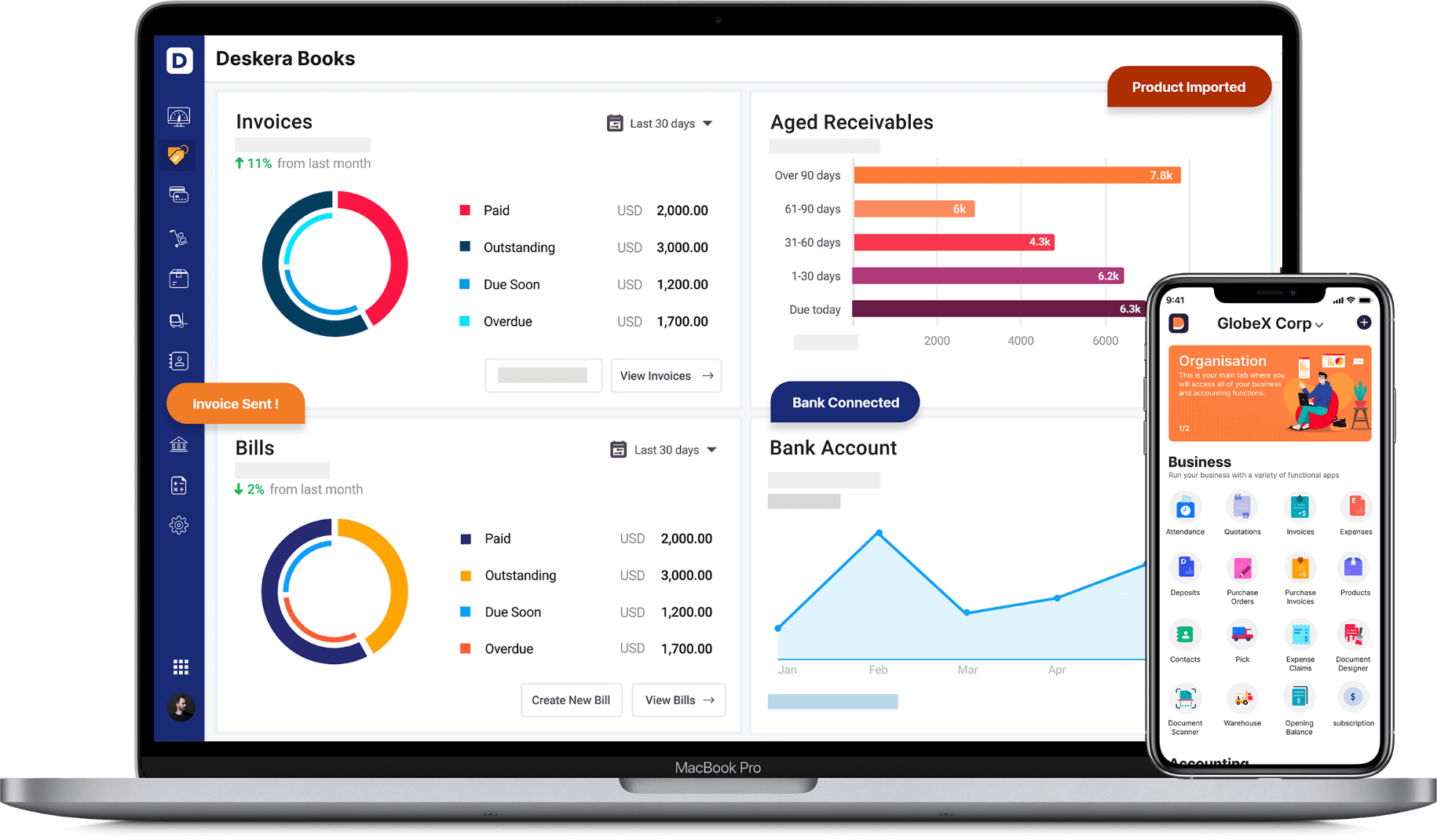A lot of organizations have transitioned into accepting chaotic procurement management as a way of conducting their business. When not corrected, the chaos only flourishes. The primary reason for the chaos is manual procurement management initiated from a register’s page with procurement management measures.

In the article, you will learn more about
- Why is Procurement Management important?
- Key Steps for Successful Procurement Management
- What are the types of procurement?
- What are the objectives of procurement management?
- Reasons why businesses need to digitize their procurement management process
- Ways to improve efficiency within procurement management
- Why You Should Automate Procurement Management
- What are Plan procurements, Conduct procurements, and Administer (or control) procurements?
- What are the steps in the procurement process?
- How can Deskera Help in Procurement Management Process?
The aim of procurement management is to ensure cost saving, efficiency, goal accomplishment of the organization, and to maintain a secure cycle. However, an organization fails to achieve it all when the process is being followed manually out of paper. Retaining the use of manual tools can drain the resources with a window for leakage of cost and theft.
The only way to do things right is by investing in adequate procurement management. But what is procurement management? Let’s understand.
What is Procurement Management?
Procurement management is an authentic process to integrate a strategic approach for procurement. The main aim of procurement management is to optimize the cost being invested by the organization. The process involves sourcing, generating requests, placing the order, an inspection of the supply received, sending invoice, and journaling the procurement process is essential. It helps in smoothly running the business while implementing it with several other benefits. A highly managed procurement process ensures a higher success rate and efficiency of the process. It also ensures cost effectiveness and cost saving for the organization. The greatest challenge an organization may face with procurement is the delay. A well managed procurement process will help the organization from escaping the delays with sourcing, ordering, receiving, inspection, and invoicing.
Why is Procurement Management Important?
Every business is run to produce revenue. While producing revenue, an organization is indulged in multiple processes. The working process is often initiated with the supply chain. Planning a procurement process can be a narrative task. Execution of the process is an entirely different task. Putting the plan from paper to the actual running process is a difficult job. This is why leveraging the capabilities of procurement management is of the highest importance. Procurement management acts as a shield for businesses and organizations.
The procurement process is a subpart of the larger process of the supply chain. However, the procurement process is the backbone of the entire lucrative functioning of a business. It is not just important but essential for the survival of an organization in the long run. Here is why procurement management is important for a business?

Seamless Functioning
Planning and execution are two different aspects of a process. While planning may be of the highest remark, poor execution can lead the entire process into leakage of productivity and efficiency. This enforces pressure on the functioning of the process. This then enforces pressure on the revenue generation and sustainability of the business. A verified and substantial procurement management ensures the seamless functioning of the business and organization. This is why it becomes mandatory for a business to invest in the right procurement process. To understand the function better, efficient procurement management helps in -
- Reduction of manual labor
- Leading in a specified direction
- Stimulating the growth with productivity
- Facilitating the staff with services and resources
- Auditing the steps and the process
An efficiently established procurement management combines all these benefits in one. This is how a business is able to successfully function with the incorporation of the right procurement management.
Adequate Acquisition of Services
Procurement is the process of acquiring essential supplies and services for the functioning of the business. The aim of procuring products and services for an organization is the smooth running of the business along with the production of the revenue generating the final product.
The process that leads to the final product includes raw material as well as services to facilitate the complete process. The employees and staff generate the requirement of services they need. The procurement team then analyzes the need and works on the requirement. Here the procurement management plays a vital role. The management -
- Helps in assessing the adequate services required
- Setting cross processing to ensure better functionality
- Sourcing the services and suppliers
- Acquiring an adequate amount of facility for the staff
A well-researched and goal-optimized procurement management establishes the service requirements as a priority. The management then efficiently combines all the benefits to produce the desired result. In the end, the staff is provided with adequate services required.
Saving Resources, Money, and Time

The primary aim of a procurement process is to procure goods and services. But the process also focuses on procuring goods while saving variable cost, efficiently investing time and sustainable use of resources. An authentic and verified procurement management will ensure the productivity curve stays high. The investment will be made in consideration of saving costs, time, and resources, as much as the organization can. Procurement management will
- Ensure the right negotiation on supply
- Sync for efficient delivery and supply time window
- Sustainable consumption of resources
- Easier auditing aspects for the process
A rectified and highly efficient procurement management will provide an organization with all these benefits. The optimization of fruitful procurement management is always done with a consideration of saving costs, money, and time. Along with the factors, procurement management also adds up to the above-mentioned benefits.
Reducing Errors
A manual job always has room for errors. Every task carried out by a human has a scope of errors. The more systemized and organized a process is, the fewer errors will be made and recorded. There are several ways in which procurement management reduces errors in the process. The procurement management will
- Conduct a thorough inspection on delivery, invoice, and current stock.
- Manage and rectify the process when needed to yield improved results.
- Cross auditing of the process by employees in different positions.
Digitizing the whole process using Deskera Books. A detailed step-by-step procurement process is the cultivator of fewer errors. Procurement management takes up the process from papers to execute it with precision. This way, an organization is able to execute the process in a refined way. This also helps an organization understand the errors and rectify the process to achieve better results.
Minimizing Delays
Time is money. No organization or business can accomplish its goals with wasted time. To ensure the organization is not drained out of its precious time, the procurement management works with time precision. The process of analyzing time usage begins right from generating orders to ordering and receiving supplies, to finally initiating the payment for the supplier. Procurement management
- Assesses the time consumed to draft the requirements
- Observes and reduces the time duration for order and supply
- Reduces the inspection time with verified steps in the process
- Analyses the time duration taken by the complete procurement process
Procurement management in the end will take all the points into consideration to draw a result. The management is optimized to reduce the time consumed and churn the process faster. This saves the organization with money, efforts of the labor and staff, and poor execution.

Lucrative Contracts
Contracts are systematically made to establish law full relationships and safety on both ends. A contract secures the business and the supplier with deliverables and orders, monetary agreements, time consumption, and a lot of other aspects. Lucrative contract building is essential in procurement management to maintain a healthy relationship with the supplier. Procurement management can have multiple types of contracts.
- Short term – 1-time contract
- Long term – 1-time contract
- Long term – multiple time contract
Contracts help in influencing security on both ends. But that is not it. Contracts also establish a constant flow of reliable supply of requirements for the business.
Key Steps for Successful Procurement Management
Management is a task encrypted with a lot of processes. If there are no or fewer processes, the management of tasks will not be effective. Procurement management is no different. When your company targets achieving a high-end procurement process efficiently, it becomes mandatory to manage it effectively.
Here are the key steps of successful procurement management. These will help you understand and incorporate the entire management process extremely well.

Requirement Generation and Planning
The first and foremost step of procurement management is to plan out a requirement generation process.
- Initiate the process by analyzing where the need is.
- Plan a process on how to analyze requirements and consumption.
- Plan a process to draft the requirement.
- Plan the next process to assess the requirement draft.
- Lastly, make a process to record the time taken to generate a requirement draft and the time duration for the next requirement draft.
Identifying a Suitable Supplier
Identifying a suitable supplier implies understanding where the next supply will be sourced from. The step involves a few processes like
- Generate a call for quotation
- Initiate a process to analyze the size of supply a supplier can efficiently provide
- Initiate a process to identify the budget and the supplier suiting your budget
- Lastly, reach out to the supplier and understand their way approach of supplying
Negotiating a Deal and Contract Building
Negotiation of a deal is a vital part of the procurement process. A procurement process targets at saving as much cost as much can be saved. Hence, negotiating becomes a non-negotiable term. The step also involves building a contract to safeguard both ends of the process. The processes needed in negotiating is
- Identifying the market cost of the size requirement you have generated
- Making negotiating in terms of money, time, supply, and more
- Locking the deal
- Signing a written contract with all the details discussed
Ordering
Ordering in itself is an entire process. Hereafter the negotiations, the supplier is presented with the order list. The company enlists the time span the supplier is supposed to take while supplying. The company then receives the supply. The process ends here without and does not require a lot of effort from a company’s end.
Supply delivery Inspection
This process begins after the organization receives the supply. There are a lot of processes involved in analyzing how fruitful the management and the process have been for business. The processes used are –
- Enrolling the receiving of the supply
- Analyzing the time take
- Thoroughly inspecting the supply
- Auditing supply for errors
- Processing the supply forward for consumption
Auditing Invoice
Invoicing is the last step. However, the process does not end at invoicing. Invoicing may seem like a quick step but the finance team has to make a detailed inspection of the invoice. The invoice should only be approved after the inspection. The process of inspection of the invoice includes
- Examination of every article present on the invoice to assess errors
- Inspection of fake/default entries if any
- Manual syncing of the supply mentioned in the invoice
- Final approval of the Invoice by the finance and procurement team together
Final Payout
The last and the endpoint of the process is the payout. Once the entire process is done, the supplier generates the invoice. This invoice reaches the finance team. The finance team then takes a thorough inspection of the invoice before approving it.
Once approved, the finance team initiates the payment for the supplier and marks the end of the contract or the process. The contract may or may not go further.
What are the Objectives of Procurement Management?
The prime objective of procurement is to save cost and supply the requirement of the business in the most convenient and conventional ways. Deriving through the same, the main objective of procurement management is to process an errorless system for the procurement process.
Procurement management runs through an entire ecosystem. This ecosystem has some major and some minor objectives. These objectives can be from the perspective of the staff or the business. Here are some of the key objectives that you and your business cannot afford to ignore or miss.

Cost Effectiveness
Establishing cost effectiveness is undeniably the prime objective of procurement management. A strong process working with cost effective measures goes long way. This way the business is able to produce more with less investment and make more profit at the end of the day.
With a well established cost-effective management, the business is also able to invest the same amount towards facilitating the working capacity from the perspective of labor and staff of the business.
Efficient Operation Conduction
A procurement process is a compilation of several different processes working in the same direction to meet an end goal. The objective of procurement management is to ensure all these processes run swiftly committing as few errors as possible.
Procurement management works with the objective of efficient operation conduction. With this, each step process finishes off with a strong base for the next process to begin.
Delivering Value
There are two ways to conduct any operation. One is to do it just for the sake of finishing a task. The other one is doing it with utmost effort to bring out the required value for a business.
Procurement management works with an objective to meet the goals of the business while running a hampered operation process. The management delivers value to the organization, to the employees, to the laborers, to the supplier, and to the final customer.
Responsible Sourcing
Who is the supplier? Where is the supplier delivering the supply from? How is it produced? Is it violating any human rights? Is it exploiting any human or an organization? Is it coming from unethical sources? Is it harming nature in any way?
There are a lot of questions that come with when sourcing a supply. Procurement management ensures the sourcing is done in the most ethical way. The management runs a background check on the supplier and the sources of the supply to ensure no violating practices are being conducted through the process.
Meeting Organization Goals Ethically
An organization is built with a lot of goals. Procurement management makes sure all these goals are fulfilled. Procurement management also ensures all the processes are being operated ethically.
Businesses have multi-tier goals that need sourcing from the outside. Procurement management ensures the sourcing runs ethically as well.
Reasons why Businesses Need to Digitize Their Procurement Management Process
A business is run to make a profit. The more errors a business commits, the less profit it makes. To eliminate errors in procurement management the business needs to ensure error-free procurement management.
Manual labor and manual management is entitled to make mistakes and errors. This is why relying on paper-based procurement management is not an ideal approach. To ensure a swift, smooth, and fast procurement businesses need to digitize the management.
The digitized procurement process takes control over everything from incorporating the types of inventory to auditing the invoice generated by suppliers. The digitized process is more efficient, ensures accuracy, and runs at even lower costs. This is why if you are running a business, you must consider switching to digitized procurement management.
With digitized procurement, process management turns into an automated process. This means automatic tracking of inventory, supply, invoicing, procurement performance, supplier performance, and varied different aspects.
The automated digitized procurement management also helps businesses in establishing better relationships with suppliers. There are a lot more ways in which digitizing the process adds value and benefits for the business. Here are some important reasons why a business should invest in digitizing procurement management.

Cost Implementing Improvisation
Saving cost on inventory is a must for more gross profit production for a business. For the same, it is vital to enhance inventory cost . Digitizing the process allows the tools to design a requirement and work with the least cost implementing process for inventory.
Elimination of Extra Expenditure
Manual operations can at times misjudge the expenditure. A separate flow of cost could be flowing out from the business that does not add much value. An automated digitized procurement management system will be able to analyze and eliminate it.
Managing Less Production Time and Cost
Digitized procurement management is able to assess and analyze each process. The analysis draws a result. This helps the procurement team to understand how less time and cost can be used in production. This indirectly impacts the profit margin for a business as well.
Better Spend Visibility
Digitized procurement management assorts everything automatically. The statistics and the records are made and placed in an easily accessible way. This makes it convenient to clearly see the spend. The procurement management team can therefore get clear visibility on the spending flow from the budget. They can then increase and decrease spend where ever required.
Higher Efficiency
Digitizing the procurement process eliminates the manual labor in a lot of departments. The process is clearly defined and measures are well expressed. This makes the understanding of the process extremely simple. This makes the entire process easy to understand and adapt to. Ending it with higher efficiency induced in each step.
Reduction in Errors
Manually doing a task, a calculation, or an analysis has the potential for errors. However, a digitized management system is automated and does not require a lot of manual work. This helps the process to run with minimum errors.
Ways to Improve Efficiency with Procurement Management
A procurement process is conducted with several objectives. A business needs a solid procurement process to fulfill all these objectives. But the process cannot run swiftly without great procurement management.
A business can run with procurement management but only a great procurement team can ensure solid procurement management. Procurement management incorporates the operation of multiple processes. This can cause confusion and failures of operations.
To ensure procurement management yields the highest results, the process should be efficient. Here are 7 ways to ensure high efficiency.

Enhanced Relationships with Suppliers
Suppliers are the main component when it comes to a procurement process. A procurement manager will be and should be surrounded by suppliers. To make sure the business can have a trusted association with a supplier, maintaining a relationship becomes important.
Enhancing relationships with suppliers provides business hassle-free, long-lasting trust worthy associations with suppliers. This can save the business from errors, frauds, unethical sourcing, and a lot more.
Make Mindful Purchases
The staff of the business has the job to generate a requirement draft with all the needed inventory and facilities. The procurement team on the other hand has to take the decision on which requirements to cater to. The procurement process saves costs for the business. But the process is also entitled to make a wiser purchase decision.
The procurement management team has to make mindful purchases to ensure higher efficiency.
Negotiating Measures should be Established
Negotiation is a non-negotiable skill for a procurement manager. The main aim of a procurement process is to save costs. The only measure that can help a procurement team save costs is negotiation.
Negotiating on the right terms can get a business a better relationship with suppliers and better supplies. Meeting the main goal, negotiations ensure the best cost a business should give. Negotiations also include contract building and agreements.
Enlarging the Network
A business constantly needs new suppliers, new dealers, and new members in the procurement process. This demands a larger network for businesses and procurement managers. Enlarging the professional network can enhance and prove to be efficient in procurement management.
There are multiple channels that can be used to grow the network. Leverage social media, existing suppliers, suppliers of competitors, employee connections, etc.
Leverage Technology and Tools
Manual operations are less time and cost-efficient in comparison to digitized operations. To ensure efficiency with procurement management a business should invest in tools and technology. A systematic technological measure always provides more efficient results.
Tools help in keeping processes and operations more organized and operative with minimal effort. A business should invest in better technology and tools to achieve better results.
Conduction of Regular Mock Training
The better practiced the staff is, the higher results they will be able to achieve. Regular mock training should play a major role here. Mock training make sure the staff has enough practice and recognition of technology and facilities.
Mock tests also open up the opportunity to analyze the process and take corrective measures. This boosts up the efficiency of every step process and the entire management as well.
Planned and Organized Sourcing
Sourcing can be difficult when not planned and organized in advance. Sourcing is a long process and needs a step-wise organization to efficiently accomplish. This includes calling for quotations, drafting the requirement, building relationship with suppliers, and receiving and inspecting the supply.
When done with pre-planned and organized steps, the process becomes more efficient with fewer errors.
Why You Should Automate Procurement Management?
Most companies are still stuck to the traditional methods of procurement management. If you are dealing with the same, you will understand how messy the process can get. Non-automated procurement management directly becomes labor-oriented procurement management. This involves an excessive amount of time consumption and paperwork. Tons of papers are involved in the recording of the processes. This ultimately brings the opportunity for errors.
Manual procurement management also opens a window of opportunity for fraud. These frauds can be committed by the employees or the suppliers. Human employees may overlook or miss out on the frauds. An automated process analyzes things in detail. From generating the requirement draft to initiating the pay, all the processes are managed in the right way.
Here are some of the most important reasons a business should automate its procurement management.

Digital Quotation Request Forms
Makes it easy for the supplier and the procurement team to communicate better on the requirements and quotations.
Digitized Requirement Draft
Helps the staff to organize and orderly feed their requirement for the procurement team to take the process further.
Digital Analysis and Approvals
The automated procurement management tools conduct and analyze on their own. The procurement team has to keep it updated with information and most all tools do the rest of the work on their own.
Digital Inspection of Supply
Automated procurement management ensures thorough inspection of the supply in accordance with requirements and usage.
Automated Invoice Inspection
Invoice inspection needs a keen and concentrated eye. The slightest mistake can cause the business a huge loss. An automated procurement management process ensures the invoice is thoroughly inspected before approving it.
Sorting Ideal Suppliers
The automated tool can analyze data and supplier information. Then as per the requirement, the supplier can be picked by the tool itself.
Reduced Errors
Elimination of manual tasks helps the management in reducing errors. With automated procurement management, the errors in the process are almost negligible.
Reduced Cost and Time Consumptions
Automated processes are run on technology and tools. This automatically reduces the time and cost consumption that a manual process would have taken.
Better Spend Visibility
Vital to make an informed decision for ordering and purchasing.
Better Control on Processes
Automated procurement management is able to analyze the process better. If the process is not meeting desired results, the automated management will be able to take better measures to correct and improvise the management.
What are Plan procurements, Conduct procurements, and Administer (or control) procurements?
Procurement management is an elaborated process. The process involves a procurement team that searches for people outside the team to get a job done. For instance, the procurement team finds suppliers, deliverers, sources customer services when needed, etc. This takes multiple tiers of management in the procurement management process.
To understand the entire flow better, here is a detailed explanation of each of the procurement management.

Plan Procurement
Planning a procurement process means establishing several processes at once. The procurement team has to ensure the requirements of the staff and laborers of the business are met in the right way. The team has to approach outside suppliers and vendors to meet the requirement. The team also has to run checks on inventory control to make sure they are meeting the right requirements.
This phase of procurement management involves
- Planning the requirement
- Identifying and selecting the vendors
- Marking out the potential risks
- Building contracts
The procurement managers in this stage have to work on their relationship-building and communication skills. The next step comes to take out a thorough inspection of the suppliers and their backgrounds. They have to learn to close deals with the right negotiations.
After planning the entire process the next step is to calculate which type of contract is to be built with the supplier. Once the contract is signed, it acts as a safety term and obligation between the business and the vendor.
Conduct Procurement
After planning is done, this phase requires the execution of the plan. Execution again involves a multi-tier of processes. For execution, the team has to get involved in a list of tasks that involves
- Calling for quotations from suppliers
- Calling for complete information by suppliers
- Selecting and proceeding with suppliers
- Analyzing and building contractual terms
The collected information has to be recorded by the procurement team. The information can come in handy for future associations. The information can also help a business in establishing better relationships with a community and network of suppliers. The information also helps in understanding the requirement of the buyer and the supplier both.
Once the requirement is analyzed and contracts are set, the order is placed directly.
Administer Procurement
Administer procurement management is the last phase of procurement management. This phase of management is not involved in execution. As the name suggests, this phase includes administrating the process. It helps in making taking alternative steps for the steps not producing desired results.
This phase includes
- Inspection of the supply
- Inspection of the invoice
- A thorough check of supply quality
- Efficiency analysis of the supplier
- Analysis of the entire process
Administer procurement is the phase that allows the team to analyze and rectify the process and contracts if needed. The target stays to run a highly efficient process. The procurement team in this phase ensures the procurement process is providing high efficiency.
Administer procurement also provides scope to build a better relationship with outside vendors and teams.
What are the Steps in Procurement Process?

Identification of Requirement
The first and foremost step of a procurement process is to identify the requirement of a business. The staff and labor identify the requirement of inventory and enlists it. Most businesses carry out this process manually however, there are a lot of tools to digitize the process.
Preparing Requirement Draft
Once the inventory is ready to present their requirement, they prepare a draft with details of the inventory required. The procurement team or the head of the inventory team cross-checks the requirements to analyze them. The team then prepares a draft of the requirement with mentioned quantity, use, and other details for the inventory and facilities.
Analyses of Requirement
The draft of the requirement is sent to the procurement team. The procurement team first analyzes the draft on the basis of inventory turnover rate, the need of the inventory, and productivity of the inventory provides. Once approved the draft is forwarded to the finance team to allocate the budget required to procure the requirement.
Supplier Selection
The most important step in the procurement process is to find and select a supplier. The procurement team invites quotations on their requirement from various suppliers. These quotations are then thoroughly inspected to match the requirement. Once the team is able to find its ideal supplier, the team runs a background check and finalizes the supplier.
Negotiation of Terms and Price
Once the supplier is selected, the business and the supplier discuss their terms and conditions. The business then negotiates on the prices and the budget of the supply. Once agreed on similar terms, a contract is built to ensure safety for both ends. This also ensures a better work relationship between the supplier and the business.
Inspection of Delivery
The second last step of the procurement process is to receive and inspect the supply. Once the delivery is made by the supplier, the procurement team gets to work. The team inspects the quality, quantity, and errors in the supply if any. This helps businesses in saving extra costs expenditures.
Invoice Approval and Payment
The last and final step of the procurement process comes with the invoice. As the business receives an invoice for the supply, the finance team inspects the invoice. A thorough check of the invoice is done in accordance with the supply received. This helps the business in saving extra expenditure. It also protects the business from frauds and wrong entries in the invoice.
Once the invoice is approved, the finance team initiates the payment.
How can Deskera Help in Procurement Management Process?
Manual procurement management can be messy and inefficient. A lot of businesses traditionally carrying out procurement management experiences a lack of cost saving, inefficient work processes, and weak relationships with suppliers.
To enhance the entire system, Deskera offers multiple software and tools. Deskera Books is the greatest software to keep a track of inventory. The software allows automatic loss and profit entry in journal books of the business. The journal entry helps businesses in keeping better records.

Deskera offers automated inventory management features among others. The software offers HR, attendance, customer relationship management, and payroll management. This makes procurement management simple by keeping easy track of the employees of the business.

Key Takeaway
- Procurement management is the key to an efficient and cost saving procurement process.
- Procurement management has hundreds of objectives. Although the major procurement management objectives are cost effectiveness, efficient operation conduction, delivering value, responsible sourcing, and meeting organization goals ethically.
- Digitized business procurement ensures higher levels of efficiency, errorless process, and cost and time saving to ensure higher productivity through the procurement process.
- Automating the procurement process will provide a swifter flow of work, saved men power, escape from errors, simpler management execution, and better end results.
- A procurement management process is divided into 3 phases. These phases are plan procurements meaning the planning phase, conduct procurement meaning execution phase, and administer (or control) procurement meaning controlling and analyses phase.
Related Articles










